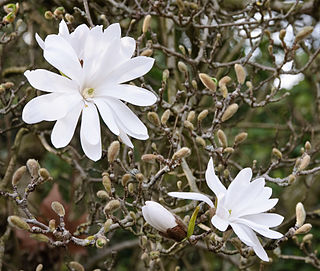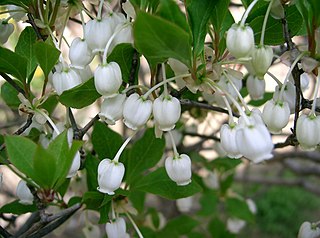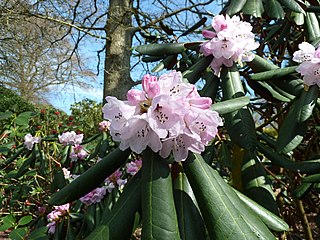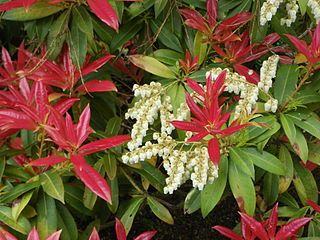
Magnolia stellata, the star magnolia, is a slow-growing deciduous shrub or small tree native to Japan. It bears large, showy white or pink flowers in early spring, before its leaves open. This species is closely related to the Kobushi magnolia, and is treated by many botanists as a variety or even a cultivar of that. However, Magnolia stellata was accepted as a distinct species in the 1998 monograph by Hunt.

Fremontodendron, with the common names fremontia and flannelbush or flannel bush, is a genus of three known species of shrubs native to the Southwestern United States and northwest Mexico.

Erica cinerea, the bell heather, is a species of flowering plant in the heath family Ericaceae, native to western and central Europe.

Chrysalidocarpus lutescens, also known by its synonym Dypsis lutescens and as golden cane palm, areca palm, yellow palm, butterfly palm, or bamboo palm, is a species of flowering plant in the family Arecaceae, native to Madagascar and naturalized in the Andaman Islands, Thailand, Vietnam, Réunion, El Salvador, Cuba, Puerto Rico, the Canary Islands, southern Florida, Haiti, the Dominican Republic, Jamaica, the Leeward Islands and the Leeward Antilles. Its native names are rehazo and lafahazo.

Spiraea japonica, the Japanese meadowsweet or Japanese spiraea, is a plant in the family Rosaceae.

Itea virginica, commonly known as Virginia willow or Virginia sweetspire, is a small North American flowering shrub that grows in low-lying woods and wetland margins. Virginia willow is a member of the Iteaceae family, and native to the southeast United States. Itea virginica has small flowers on pendulous racemes.

Kolkwitzia amabilis, commonly known as beauty bush, is a species of flowering plant in the family Caprifoliaceae. It is the sole species in genus Kolkwitzia. It is a deciduous shrub grown as an ornamental plant. In China, where it originated, the plant is called wèi shí (蝟实).

Erica lusitanica is a European species of flowering plant in the family Ericaceae, known by the common names Portuguese heath and Spanish heath.

Enkianthus is a genus of shrubs or small trees in the heath family (Ericaceae). Its native range is in Asia, as far west as the eastern Himalayas, as far south as Indochina, and as far north and east as China and Japan.

Rhododendron bureavii, the Bureau rhododendron, is a species of flowering plant in the heath family Ericaceae. It is native to western Sichuan and northern Yunnan, China, where it lives at altitudes of 2,800–4,500 m (9,200–14,800 ft).

Enkianthus perulatus (dodan-tsutsuji) is a species of flowering plant in the family Ericaceae, native to Japan. It is a compact, slow-growing, deciduous shrub eventually growing to 2 m tall and wide. Pendent umbels of pure white, bell-shaped flowers in spring are followed in autumn by brilliant red and yellow leaf colours. Its leaves are ovate and medium to bright green in colour. It grows in sunny woodland areas.

Rhododendron fulvum is a species of flowering plant in the heath family Ericaceae, native to northern Myanmar and China. In China, it is found in southwest Sichuan, southeast Xizang, and western Yunnan. It grows at altitudes of 2,700–4,400 m (8,900–14,400 ft). It is an evergreen shrub or small tree growing to 2–8 m (6.6–26.2 ft) in height, with leathery leaves that are oblanceolate to oblong-lanceolate or obovate, 8–20 by 3–7.5 cm in size. The undersides are felted with a striking cinnamon colour. The flowers, borne in trusses in spring, are loosely bell-shaped, pale rose pink, with a crimson basal blotch and sometimes red spots.

Rhododendron davidsonianum, the concave-leaf rhododendron, is a species of flowering plant in the heath family Ericaceae that is native to the forests of Sichuan, China, where it lives at elevations of 1,500–2,800 m (4,900–9,200 ft). Growing to 4 m (13 ft) tall and 2.5 m (8.2 ft) broad, it is an upright evergreen shrub. The glossy leaves are lanceolate and up to 6 cm (2.4 in) long. In spring trusses of bell-shaped, pale pink or purple flowers are produced.

Rhododendron macabeanum, the McCabe rhododendron, is a species of flowering plant in the heath family, Ericaceae. It is native to Assam and Manipur in northeastern India. It is a large evergreen shrub or small tree growing to 12 m (39 ft) in height, with leathery leaves up to 30 cm (12 in) in length. The felted undersides are a grey or buff colour. The flowers, borne in trusses in spring, are bell-shaped, pale to deep yellow, with a purple basal blotch.

Rhododendron makinoi, the Makino rhododendron, is a species of flowering plant in the heath family Ericaceae that is native to Japan. It is a compact evergreen shrub growing to 2.5 m (8.2 ft) tall and broad, with woolly young shoots and long narrow curved leaves, heavily felted brown on the reverse. The flowers, borne in trusses in spring, are bell-shaped, deep pink in bud and opening pale pink, with red spots on the interior.

Rhododendron williamsianum, the Williams rhododendron, is a species of flowering plant in the heath family Ericaceae. It is native to forested slopes at 1,800–2,800 m (5,900–9,200 ft) in western Guizhou, southwestern Sichuan, southeastern Xizang and northeastern Yunnan in southern and western China.

Stachyurus chinensis (中国旌节花), Chinese stachyurus, is a species of flowering plant in the family Stachyuraceae, native to China and Taiwan. It is a spreading deciduous shrub growing to 2.5 m (8 ft) tall by 4 m (13 ft) wide. Stiff, pendent racemes of bell-shaped, greenish-yellow flowers are borne on glossy, dark brown branches in winter and spring. It flowers two weeks later than the related S. praecox. The flowers are followed by simple ovate leaves which colour to pink and red before falling in autumn.

Photinia × fraseri, known as red tip photinia and Christmas berry, is a nothospecies in the rose family, Rosaceae. It is a hybrid between Photinia glabra and Photinia serratifolia.

Pieris formosa, called the Taiwan pieris or the Himalayan andromeda, is a species of flowering plant in the genus Pieris native to Nepal, the eastern Himalaya, Assam in India, Myanmar, Vietnam, Tibet, central and southern China, but not Taiwan. The 'Wakehurst' cultivar of the variety Pieris formosa var. forrestii has gained the Royal Horticultural Society's Award of Garden Merit as an ornamental, and is also considered by them as a good plant to attract pollinators. A vigorous evergreen shrub to 4 m (13 ft) in height, its leaves open red in early spring, turning green later. The trusses of creamy white flowers open at the same time as the young leaves. Like all pieris, it prefers a partially shaded spot in acid pH soil.

Enkianthus cernuus, the nodding enkianthus, is a species of flowering plant in the family Ericaceae, native to southern Japan. A shrub or small tree that prefers to grow in wet areas, Enkianthus cernuus f. rubens, the drooping red enkianthus, has gained the Royal Horticultural Society's Award of Garden Merit.



















